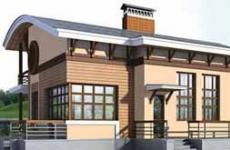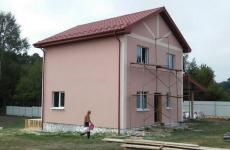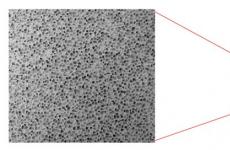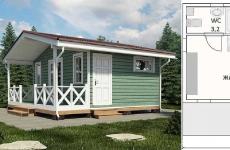A condensing boiler is the best solution for heating a private house. The principle of operation of a condensing boiler Pros and cons of condensing heaters
Energy-saving technologies and economical use with maximum efficiency of energy resources are becoming more and more relevant topics. Condensing boilers is the result of applying the unique technologies in heating technology. They have the highest efficiency - 15-17% higher than conventional atmospheric boilers, service life is 2-3 times longer, a wide power range (up to 100 kW or more).
Due to its effectiveness condensing boilers are very popular in Europe, for example in Germany 70% of heating boilers are condensing.
Principles of operation of a condensing boiler is based on the receipt and transfer to the coolant of additional thermal energy released in the process of condensation of water vapor.
V gas boiler direct combustion, the transfer of thermal energy to the heat carrier occurs by heating the heat exchanger gas burner in which the combustion process takes place. One of the components of the gases formed during the combustion process is water vapor, which in turn appears as a result of the combustion of hydrogen present in natural gas. Part of the water vapor from the heating boiler, together with flue gases, exits through the chimney into the atmosphere, and part in the form of condensate is discharged through the condensate pipe of the chimney (usually to the bathroom).
In direct combustion gas boilers, condensation is a negative factor; in condensing boilers, the process of water vapor condensation is the main condition on which the operation of the boiler is based.
It is designed in such a way that water vapor having a temperature of 130 to 150 °C is cooled by a heat carrier from the return line of the heating system to a temperature below 57 °C. It is at this temperature that water condenses, and the latent thermal energy from the condensation process is transferred to the coolant itself and is added to the heat obtained as a result of combustion. natural gas. As you can see, to ensure the process of water vapor condensation, the return line coolant is used. heating system.
The lower the temperature of the return heat carrier in the boiler, the more condensation heat is released, and, accordingly, the higher the boiler efficiency is main principle operation of any condensing boiler.

The maximum efficiency of a condensing boiler can be achieved at a return temperature of 50 - 30 °C. During the condensation process, a slightly acidic environment, 3-5 pH, is formed, therefore the materials from which the boiler components are made, used in humidification zones, must be resistant to acidity. In high temperature areas aluminum alloys and stainless steel are most commonly used, in low temperature areas plastics (eg polypropylene) are the most cost-effective.
The heat exchangers of condensing boilers are manufactured using of stainless steel and aluminum, equipped with a condensate collection and removal system, as well as a blower with a stepped power system. By controlling the fan speed, an optimal air-to-gas ratio for the combustion process is achieved and a high efficiency is achieved. For an efficient gas combustion process, injection burners with flame modulation are used. Removal of products of combustion of gases occurs forcibly through coaxial pipe. The flue gas temperature is 40-50 °C
OPERATION
For maximum efficiency condensing boiler must be operated within a certain temperature range. If the operating temperature is between 60 and 80°C, little water vapor condensation will occur and the efficiency of the condensing boiler will be approximately 98%. For comparison, a traditional chimney gas boiler has an efficiency of 92% - there is a difference, but it is not significant. If the worker temperature regime heating system will be from 53 to 30 ° C, then there will be a significant condensation of water vapor and the efficiency will increase to 107-111%. When calculating the efficiency, the thermal energy from gas combustion is taken as 100%, the energy received from the condensation process is added to it, therefore, a value of more than 100% is obtained.
The main condition for achieving maximum efficiency- use condensing boilers on low-temperature heating systems, preferably specially designed for them, with a temperature regime not higher than 60-40 ° C, maximum 70-50 ° C).
Underfloor heating systems with a coolant supply temperature of 40-45°C and a return line temperature of 35-30°C are most suitable for these requirements; radiator heating systems with a coolant supply temperature of up to 70°C and a return line temperature of 50°C are less suitable.
Modern energy-saving technologies can significantly save on heating, condensing boilers further reduce energy costs and improve living comfort.
In order to understand how much more profitable it is to purchase a condensing boiler, it is necessary to compare its characteristics and parameters with a gas boiler. The products of combustion in a simple gas boiler pass through the heat exchanger of the device, so some of the heat will be lost. This can be explained by the fact that, together with the exhaust gases, a certain proportion of hot vapors will also go into the atmosphere. The condensing boiler keeps this thermal energy in the form of steam, so it is considered more efficient than a simple gas boiler.
After the vapor cools, it turns into a liquid. Due to this condensation process, some heat will be released. In a conventional boiler, during its operation, a phenomenon such as condensation is fought, and in the case of a condensing boiler, condensation is a beneficial phenomenon. The condensation process takes place in a heat exchanger, which, compared to a gas boiler, has several larger size. This component of the condensing boiler extracts heat energy for the heating system.
The heat that is generated during the complete combustion of a fuel unit, taking into account the steam that is released during the condensation process, is called the "higher" heating value of the fuel.
The "lower" calorific value will be called the amount of heat without taking into account condensation heat.

Condensing heating boilers have become popular relatively recently, although the principle of their operation was known to mankind more than 100 years ago. Today, thanks to technological progress in the manufacture of boilers, alloys have begun to be used that have good resistance to corrosion and other destructive processes.
Features of condensing boilers
Based on the laws of physics, it is necessary to understand that even slight heat losses are inevitable in any case and the efficiency will not reach 100%. Compared to gas boilers, condensing boilers are more economical. This figure for condensing boilers is higher by about 15-20%.

Condensing boilers are equipped with more modern burners, which minimizes the likelihood of incomplete combustion of the fuel. Together with the exhaust gases, much less harmful substances are released and the temperature of the exhaust gases also decreases, which rarely exceeds 40 degrees. For such boilers, plastic chimneys can also be used, which saves on this component of the heating system. It also reduces the cost of installing chimneys.
As for the execution, the condensing gas wall-mounted boilers are almost in everything similar to traditional gas boilers.
Most often, condensing boilers are wall-mounted, but there are also powerful floor-standing devices. Such boilers are rarely used for residential premises. Basically, they can be found in office space or in production.

The main difference from conventional boilers is that in condensing boilers the heat exchanger is made of materials with good resistance to various acids. Usually such materials are stainless steel or silumin. Due to the high acidity, condensate is formed, and it causes a corrosion process if such alloys are used that are used for the manufacture of non-condensing boilers.
The main components of the condensing boiler
The heat exchanger for condensing boilers can be made in the form of pipes with a complex cross section. This is necessary in order to increase the volume of the heat exchanger as much as possible, thereby increasing the efficiency of the condensing boiler. In boilers of this type, a fan is mounted in front of the burner, which extracts gas from the gas pipeline and mixes it with air. Further such working mixture heading towards the burner.
Flue gases leave the system through coaxial chimneys.
For the manufacture of such chimneys, manufacturers mainly use plastic, which has good heat resistance. The pump integrated in gas condensing heating boilers is electronically controlled and optimizes the output of the boiler, thereby saving electricity.

The efficiency of the boiler largely depends on the parameters of the heating system as a whole. If the water temperature is low, then the condensation of water vapor will occur more fully. Thus, a significant part of the latent heat will be returned to the heating system. This will also affect the fact that the efficiency of the condensing boiler will be slightly higher.
Not every heating system is suitable for a condensing boiler. The heating system must be designed for a not too high coolant temperature.
That is, it should be a relatively low-temperature heating system. In the return circuit, the coolant must have a temperature no higher than 60 degrees. Outside conditions don't matter. If there is a slight frost on the street, then the temperature of the coolant in the return circuit will not be lower than 45-50 degrees. Thus, the boiler will operate in condensing mode.

Low-temperature heating boilers can be either with one or with two circuits. They can be used to organize a heating system or for hot water supply. Such boilers may vary in power parameters. Their power range is quite large and ranges from 20 to 100 kW. Such power, which is provided by low-temperature heating at home, is enough for any living conditions.
For an industrial area, you will need to purchase a more powerful floor-standing boiler.
You can also purchase various kits for connecting condensing boilers. The list of such components includes: condensate neutralizers, expansion tanks, various safety devices, exhaust gas kits, piping kits and more.
In many European countries, the use of boilers other than condensing ones is prohibited. This is due to the fact that they have a higher efficiency and they emit much less harmful particles into the atmosphere. In such countries, the state takes care of its people, because it prohibits the use of equipment that does not have good economy and a low level of environmental safety.
The complexity of applying the condensation principle used to be that the accumulated condensate in a gas heating boiler led to corrosion of metal structural elements. The problem ceased to exist when corrosion-resistant alloys and stainless steel began to be used for the manufacture of equipment.
Boiler device
Condensing boiler - what is it in terms of design?
The main working element is a stainless steel heat exchanger in the form of a coil. Inside the spiral is a heating element(burner). The coolant enters the coil from the return, heated by the burner.
From the side of the inlet pipe, where the water is the coldest (less than 59 degrees), steam condenses on the walls of the chamber. In condensing models, the combustion chamber closed type, i.e. The boiler takes the combustion air from the street, and the combustion products do not leak into the boiler room.

The system is equipped with:
- circulation pump, forcibly distilling the coolant (located on return pipe, equipped with a filter);
- coaxial chimney (double pipe, for air supply and smoke removal at the same time), connected at the top of the unit;
- fan for forced air supply to the burner;
- steam trap.
The circuit includes protection and control devices (). Modern models of boilers allow the possibility remote control, starting with remotes and ending with SMS.
Pros and cons
Conventional or condensing boiler - which is better, and in what situations?
The main advantages of condensing units are high efficiency and economy. Thanks to the design of the burner (), the fuel burns out almost completely, the amount of waste is minimal - that is, this boiler is also environmentally better.
The smoke temperature is below 40 degrees - this means that plastic chimneys can be used, and they are cheaper than metal ones. Due to the smaller amount of combustion products and built-in forced ventilation smaller pipes can be used.
The advantages of this boiler equipment include:
- compactness, light weight;
- easier installation;
- modulating burner;
- gas savings, an average of 35%;
- low noise and vibration levels;
- savings on the chimney;
- environmental friendliness (7 times less harmful emissions);
- cascade installation is possible (several boilers in a common system).
The main disadvantage is the high price, but in a properly organized heating system, the difference pays off.
Features of condensation models
The principle of operation of condensing boilers is such that a small temperature fork between supply and return is needed for operation. This means that the initial temperature of the coolant should not be too high. Therefore, it is believed that the most effective use such models.
Like a simple gas boiler, a condensing boiler exists in design. The advantage of the floor - higher power, wall - compactness. The power of the unit is selected at the rate of 1 kilowatt per 10 square meters plus 10% of the reserve.
For small house a high power boiler is not needed. Compact and environmentally friendly wall model can be hung in the kitchen, you do not need a separate room for the boiler room.
Video about the principle of operation of a condensing boiler.
In the production of heating systems, the most promising innovative technology is the condensation of water vapor, which is formed during the combustion of hydrocarbons. This is how condensing boilers work. This new heating equipment has appeared on the Russian market recently, but is already in considerable consumer demand. Condensing boilers of both foreign and domestic manufacturers are on sale.
A wide range of condensing boilers is offered by BAXI, which, thanks to the high quality of its products, has become a leader Russian market boiler equipment. Baxi condensing boilers are floor and wall condensing boilers with high efficiency. Other well-known brands of boiler equipment in the domestic market include condensing vaillant boilers and wisman.
condensing boiler
Principles of combustion and condensation
Any hydrocarbon fuel releases heat when burned. In the process of fuel combustion, carbon dioxide (CO 2) and (H 2 O) water become end products, which, under the action of high temperatures turns into steam. When evaporating, water expends heat, but it can be obtained back in the process of condensation, that is, if the water from the gaseous phase passes back into the liquid.
How condensing boilers work
The principle of operation of condensing boilers has been known for a long time, but it was impossible to use it in boiler equipment made of cast iron and steel, since water condensate, having high acidity and containing carbon dioxide, caused corrosion of steel and cast iron boilers. Only with the advent of corrosion-resistant alloys and stainless steel, it became possible to introduce this technology in the production of boiler equipment.
As we already know, when cooled, the vapor again turns into liquid state and releases a certain amount of heat. If we consider a conventional boiler, then during its operation there is a struggle with the condensation process, and in condensing boilers, condensation is only welcome. Their design provides for a special heat exchanger, in which the condensation process takes place, and the heat generated during this process is taken for the heating system.
The condensing boiler has an efficiency of 108-109%. How is this possible if, according to the laws of physics, the efficiency cannot exceed 100%, since energy losses in any processes are inevitable.
In non-condensing boilers, not all thermal energy is taken away during gas combustion, but only a large part of it. The heat flow in the heat exchanger is cooled only to a temperature of 140-160 ° C, when it is cooled to a lower temperature, the draft decreases in the chimney, aggressive condensate is formed, causing corrosion of the boiler elements. Thermal energy that can be obtained in the process of condensation in conventional boilers is not used, it is called latent.
Condensation gas boilers use in their work the energy hidden in condensing water vapor, so their efficiency, in comparison with the efficiency of conventional boilers, exceeds 100%. The main element of any boiler is a heat exchanger. There are two heat exchangers in the design of condensing boilers. They can be separate or combined (two-stage). The first heat exchanger works in the same way as in conventional boilers. A heat flow passes through it, but does not cool below the dew point. The second condensing heat exchanger removes the heat remaining from the combustion products and cools it down to a temperature below the dew point.
Water vapor condenses on the walls of the second heat exchanger and releases latent heat energy to water. At this moment, additional heat is taken from the combustion products; their temperature at the exit from the heat exchanger is only 10-15°C higher than the coolant temperature.
To solve the problem of corrosion caused by aggressive condensate, manufacturers use materials that are resistant to corrosion and chemical influences (stainless steel, silumin (aluminum-silicon alloy)) in the manufacture of boilers.
In Europe, and in particular in Germany, there are regulations requiring that condensate be neutralized before being discharged into the sewer. The neutralizer is a container with granules of magnesium and potassium. By passing through these alkaline reagents, the condensate is neutralized, and when discharged into the sewer, it does not pose a danger to environment. In Russia sanitary norms do not require condensate neutralization, so it is simply collected in a special tank provided in the boiler design, and, as a result, is discharged into the sewer in its original form. In boilers with a capacity of up to 30 kW, intended for heating private houses, about 30 liters of condensate are formed in 24 hours a day.
Advantages and disadvantages of condensing boilers

Wall mounted heating boiler
The condensing gas boiler can be called one of the most economical and highly efficient heating appliances. Its efficiency is 10-15% higher than the efficiency of a traditional boiler. In addition, condensing boilers are 20% more economical than conventional boiler equipment.
The design of condensing boilers uses high-tech burners that prepare fuel-air mixtures in optimal proportions, which minimizes the possibility of incomplete combustion of the fuel. This reduces the amount of emissions of harmful substances.
Exhaust gases have low temperature(below 40 °C), which makes it possible to use plastic chimneys for condensing boilers, thereby reducing the cost of installing the heating system.
The advantages of condensing boilers include:
- small dimensions and light weight of boiler equipment;
- efficiency (gas savings are 35% per season);
- deep modulation (saving gas at partial loads);
- low vibration and low noise;
- possibility of cascade installation;
- savings on the chimney (you can install chimneys with a smaller diameter);
- reduction of emissions of harmful substances NO X and CO 2 (7 times lower than conventional boilers).

Cascade of condensing boilers
Due to the small dimensions and low weight of the boiler equipment, the installation of the boiler requires less space at the same time, the cost of its transportation and installation is reduced. There is a misconception that condensing boilers work effectively only with underfloor heating systems. In another case, their efficiency is no more than that of traditional boilers. But it's not. The design of the condensing boiler has a modulating burner that allows you to achieve deep power modulation, while reducing the cost of gas and air.
The process of condensation in the boiler goes on during operation heating equipment With radiator system heating. At reduced loads, the efficiency of a condensing boiler may well reach high values, unlike conventional gas boilers, in which the efficiency drops in this mode due to an excess of air.
For the cascade installation of condensing boilers, manufacturers offer special regulators (for example, BAXI sells the RVA47 regulator for its boilers), which turn boilers installed separately into a single system.
The advantages of the cascade system are the ease of installation and the compact dimensions of the boiler room. Due to the reduced vibrations and low noise level during the installation of condensing boilers, there is no need to make vibration-proof platforms and soundproof the room intended for the boiler room. Which also saves cash when installing a heating system.
To save on the size of the chimney, the fan working in condensing boilers allows. He develops quite high pressure, so the diameter of the chimney can be two times smaller than when installing a heating system with traditional boilers.
Due to low NO X and CO 2 emissions, condensing boilers are classified as environmentally friendly equipment, they are often used to equip boiler houses in resort and protected areas. Finding flaws in condensing boilers is very difficult. The main disadvantage of this heating equipment is the high price, which is twice the price of conventional boilers.
Application
By appearance condensing boilers are not much different from traditional ones. They are made in wall-mounted and floor-mounted versions. Wall-mounted gas condensing boilers have less power than floor standing ones and are used in everyday life for heating private houses and cottages.
Floor-standing condensing boilers with high power are used for heating industrial facilities and office space.
Condensing gas boilers produce single and double circuit. Apply double-circuit boilers for both heating and hot water. The power of single- and double-circuit boilers is 20-100 kW. This is enough for domestic use boilers. For industrial applications produce models with higher power.
The main differences between the design of condensing boilers and conventional boilers
Condensing boilers differ from traditional boilers in the material used for the heat exchanger. Their heat exchanger is made of acid-resistant silumin alloy or stainless steel. The water condensate formed in the boiler has hyperacidity and causes corrosion of materials such as steel and cast iron, which are used in the manufacture of non-condensing boilers. The shape of the heat exchanger is a pipe of complex cross section with additional helical fins. This form of heat exchanger increases the heat exchange area and increases the efficiency of the boiler.
In condensing boilers, a fan is installed in front of the burner, which “sucks” the gas from the gas pipeline and mixes it with air, after which it directs the mixture of gas and air to the burner.

Condensing boiler device
Flue gases are removed through coaxial chimneys made of heat-resistant plastic. In addition, the condensing boilers have an electronically controlled pump that optimizes the heating output, saving energy and reducing noise from the heating medium flowing in the heating system.
The design of traditional boilers does not provide for the condensation process and the use of indoor energy, so the temperature of the combustion products is maintained at high level. Part of the heat in such boilers is not used, but is removed with combustion products through the chimney.
Since condensate is chemically aggressive, in order to use it, it is necessary to make boiler elements from chemically sustainable materials, which are quite expensive. It is much easier for manufacturers to sell cheaper products than to invest in progressive, but expensive technologies. Therefore, most of the boilers on the market are based on outdated technologies. For users, it is more profitable to buy albeit expensive, but more efficient condensing boilers that save on fuel consumption.
Manufacturers offer connection kits, condensate neutralizers, expansion tanks, safety devices, boiler piping kits, drainage systems for their condensing boilers. flue gases.
V European countries Condensing boilers are the most popular type of heating appliances. There are countries where the installation of non-condensing boilers is prohibited. The reason for this is the higher efficiency and lower emission of harmful substances in condensing boilers.
Many of our customers are tormented by the same question when choosing a heating boiler - to use condensing boilers or not? Is it true that they are more effective than traditional ones and pay off over time? And many other questions.
Let's try to understand everything in order and answer each question in detail, briefly and succinctly.
! Note to the reader
This wall-mounted condensing boiler won the prestigious "iF product design award" in the Industry/Buildings category at CeBIT in Hannover, Germany, in March 2008. Appreciated received the design of the product, the quality of the materials used, the degree of product innovation, the level of environmental impact, functionality, ergonomics, safety and appearance.
So the questions are:
Why for effective work condensing boiler requires a temperature in the heating system of 50/30°C?
50/30°C is the temperature difference in the heating system. 50°C is the temperature of the coolant in the supply pipe - "supply". 30°C is the temperature of the coolant in the return pipe - "return". For efficient operation of the condensing boiler, it is necessary that the boiler operates in condensing mode. And the condensation mode directly depends on the return temperature. To start the condensation of water vapor in the composition of the flue gases, it is necessary that the flue gases cool down to a temperature of 57°C, and this is only possible when the "return" temperature is below 50°C. In other words, if the heating system operates in such a mode in which the return temperature is below 50 ° C, then the boiler operates in condensation mode, which means it is efficient.
Is it true that a condensing boiler only works efficiently when low temperature heating(heat-insulated floor) at a temperature in system 50/30 °C? And at a temperature of 80/60 ° C does not work effectively?
In order to answer the question, it is necessary to understand in more detail the operation of the boiler. The fact is that the temperature in the winter on the street is not constant, therefore, the temperature in the heating system must change so as not to overheat the premises. After all, what will happen if, for example, it is -10 ° C outside, and the boiler will supply water to the heaters with a temperature as at -28 ° C? That's right, the room will be heated. This means that energy will be wasted. To prevent this from happening, the boiler operates in a weather-dependent mode of heat generation. That is, depending on the temperature outside, the temperature in the heating system changes. What does it give? Let's take a look at the heating schedule below.
It is very easy to build a heating schedule: it is enough to set the boundary conditions. At -28°C outside in the heating system, the supply temperature will be +80°C, and the "return" temperature will be +60°C. And at a temperature of +18°C outside, when there is no need for heating in the building, the supply and return will also be +18°C. From the last question, we remember that the boiler works efficiently at a "return" temperature of 50 ° C and below. Therefore, the graph shows that the boiler is operating in condensation mode at an outdoor temperature of -18 ° C and above. If you look at the time, how many hours in Moscow in winter the temperature drops below -18°C, and how many hours in Moscow in winter the air temperature in the street is above -18°C, it becomes clear that 95% of the time of the entire heating mode, the condensing boiler operates in the mode condensation. This means that it is more efficient than traditional low-temperature boilers.
It turns out that the condensing boiler at temperatures below -18 ° C does not work efficiently?
This is not true. A condensing boiler is at least 5% more efficient than its conventional counterparts, even when the boiler is not in condensing mode. What's the secret? And the secret is in the heat loss during the operation of the boiler. What are the heat losses? The heat loss is perfectly illustrated in the image below.

It can be seen that even without taking into account condensation, the boiler is 5% more efficient than its low-temperature counterparts. This can be clearly seen if we compare the temperature of the flue gases of condensing boilers and low-temperature boilers. The flue gas temperature of low-temperature boilers is approximately 138°C, and condensing boilers - 70°C. At this flue gas temperature, instead of metal chimneys use plastic.
How to ensure the condensing operation of the boiler at a temperature below -18°C at a temperature in the heating system of 80/60°C?
To do this, it is enough, simply, to increase the size of the heaters by 30%. And taking into account the fact that when designing a heating system, designers almost always make a margin of 10-15%, the cost of slightly larger heaters will not be significant.
How about air pollution? It is said that flue gas emissions from condensing boilers are more harmful to the environment than from low temperature boilers.
It is a myth. Flue gases from condensing boilers are less harmful to the atmosphere than from low temperature boilers. For example, carbon dioxide (CO 2) is 20% less than a low-temperature boiler and 40% less than a standard boiler.

A low temperature boiler emits 60% less nitrogen oxide (NO x) into the atmosphere than a low temperature boiler and 90% less than a standard boiler.
Okay, it releases less pollution into the atmosphere, but what about sewerage? In the condensing mode of operation, the boiler drains an acidic environment into the sewer. How to deal with it? Will sewer pipes be damaged?
Indeed, when the boiler is operating in condensing mode, it is necessary to drain acidic condensate into the sewer. But for this case there are two solutions. First, for city sewerage, there is a permit from Mosvodokanal that condensate can be drained into the sewer, but subject to dilution in a ratio of 1/25, but only for boilers with a capacity of no more than 260 kW. The second (simple) solution is to have one condensate neutralizer for the entire boiler room.
- Note to the reader
- For example, for a 60 kW condensing boiler, 14.2 m³ of condensate is released in 2000 hours. For 1 hour of operation of the condensing boiler, 14.2 / 2000 = 0.0071 m³ / hour is released. Neutralization is not required if the ratio is 1:25 - this is written both in the Buderus catalog and in the requirements of Mosvodokanal. For a house with an area of 490 m², the drainage is approximately 0.684 m³ / hour, i.e. a ratio of 1:96, which satisfies the conditions. Therefore, for this boiler, the neutralization tank can be omitted.
- The condensate is nothing but carbonic acid, which is a weak acid and polypropylene pipes does not affect.
- If there is a septic tank, then it is better to put a neutralization tank.

For example, in the scope of delivery of the Buderus boiler, there is a standard solution with three types of condensate neutralizer, differing in "tricks". The condensate neutralizer is nothing more than a container filled with a neutralizing agent.
It turns out that if there is a container and a neutralizing agent, then this agent must be changed periodically? Can you get broke?
Indeed, the neutralizing agent must be changed periodically. But one filling of the neutralizing agent is enough for 350 m³ of condensate. And when the boiler house is operating at 260 kW, only 8–9 l / h of condensate is released during the condensing mode of operation of the boiler in the most efficient mode, and this is almost 7–8 years of operation of the boiler house without changing the converter. Those. for the entire service life of the boiler, the need to replace the neutralizer will arise only 1-2 times. The cost of 10 kg of the neutralizer (one refill of the container) is 5600 rubles, so you won’t be able to go broke.
I want to place the boiler in the kitchen area. You need a neutralization tank. Will the granulate in the neutralization tank evaporate and "poison" the room?
No, it will not. The filling of the neutralization vessel is magnesium dioxide (MgO) which does not evaporate.
In the neutralizer, carbonic acid (H 2 CO 3) is neutralized, which is a substitution reaction. Nothing will evaporate, because during the reaction, the following are formed:
- magnesium carbonate (MgCO 3)
Basic magnesium carbonate 3MgCO 3 Mg(OH) 2 3H 2 O (the so-called white magnesia) is used as a filler in rubber compounds, for the manufacture thermal insulation materials. In medicine and as food additive E504 uses basic magnesium carbonate 4MgCO 3 Mg(OH) 2 nH 2 O. - water (H 2 O) - well, not a harmful substance.
Magnesium carbonate can decompose into carbon dioxide (CO 2) and magnesium oxide, which in the first case is a human waste product, and in the second - a powder that is used in gymnastics.
As already mentioned, plastic chimneys are used to remove flue gases from condensing boilers. Will there be any problems when handing over the boiler house to the supervisory authorities?
No, there won't be any problems. Everyone operates with old information about steel chimneys. In the technical regulation fire safety it is described that the chimney can be of any material, if recommended by the manufacturer. Buderus has all the permits and certificates proving that plastic chimneys are a standard, factory solution from Buderus.
What if it happens that the temperature of the flue gases exceeds the temperature of 70–80 ° C and melts the chimney?
Such a situation is impossible. The boiler is equipped with a cut-off sensor at 85°C, i.e. the boiler is switched off if such a situation occurs. The fact is that part of the boiler is made of the same plastic as the chimneys, so an increase in the temperature of the flue gases in the first place would damage the boiler structure, which cannot be allowed.
The wall mounted condensing boiler is a relatively compact unit. Apparently not very powerful. What to do if the object has a large thermal load?
Despite their compactness, Buderus wall-mounted condensing boilers are very powerful. With one standard size, there are two power options - 80 and 100 kW.
What if you need more heat output?
The fact is that condensing boilers can be combined into a cascade and receive required power. For example, one Buderus automation can combine up to 16 condensing boilers into a cascade and get 1.6 MW of power (!), And this is not at all small. But all the advantages of the cascade do not end there. Using special cascade mounting blocks, you can get up to 400 kW of thermal power from just 1 m²! It will look like this, 4 boilers back-to-back:

When using a cascade, you can not only save space, but also significantly increase the reliability of the home heating system. In case of failure of one heating boiler, automation distributes the load to the rest. And in the heating systems of houses with one floor boiler, if any element fails, the heating system stops working and the house cools down. When using a cascade, it is possible to combine all the flue outlets of the boiler into one chimney, for this there is a standard solution from Buderus.
According to the norms, it is impossible to combine several chimneys into one! Boiler room will not be accepted?
The boiler room will be accepted. It is enough to take the installation instructions and certificates. This is a factory solution with all the elements. The certificate of conformity stipulates that the boilers are certified together with chimneys.
To be continued.






